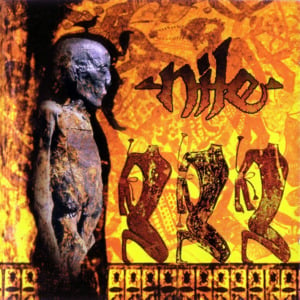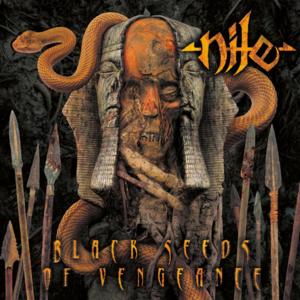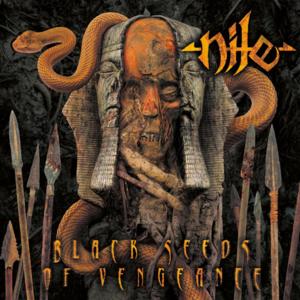Churning the maelstrom de Nile
Letra de Churning the maelstrom
Am the uncreated god
before me the dwellers in chaos are dogs
their masters merely wolves
i gather the power
from every place
from every person
faster than light itself
hail to he who is in the duat
who is strong
even before the servants of serpents
he gathers the power
from every pit of torment
from they who hath burnt in flames
from words of power uttered by the
darkness itself
Hail to he in the pit
who is strong
even before the terrors of the abyss
who gathers the power
from the wailing and lamentations
of the shades chained therein
from he who createth gods from
the silence alone
[last year, after the release of black seeds of vengeance, i received e-mails containing the text of a work whose origins had until then been completely unknown to me. entitled, "the chapter for bringing heka to those who burn," the author claimed it was part of a larger collection of works known as "the book of resurrection ; in egyptian methology, apophis is also known as apep, the terrible monster serpent who, in dynastic times, was a personification of the darkness of the darkest hour of night. apeop is the dreaded embodiment of utter evil in the form of a giant snake that arises anew each night to struggle against the sun god, ra. against apep, ra must not only fight, but must succesfully conquer morning sun, lest darkness and chaos engulf the entire earth during the day as well. apep was both crafty and evil doing, and, like ra, possessed many names, to destroy him it was necessary to curse him by each and every name by which he as known. in egyptian papyri, apep is also represented in the form of an enormous serpent, into each undulation of which a knife is stuck. in the book of gates, we see him fastened by the neck with a chain (along which is fastened the goddess, serqet), the end of which is in the hands of a god, and also chained to the ground with five chains. coincidentally (or perhaps not), apophis is also the name the hyskos king aussere adopted during his reign over the conquered and subjugated egypt of 1570 the hyskos had invaded egypt and established their new political and religious capical city, avaris, in the delta region of egypt. avaris is also the site of the original temple of set. set (or sutekh, to the hyskos) wa the chief god of the hyskos at that time, but in egyptian mythology since pre-dynastic times, set was the murderous brother of osiris, and the original ultimate embodiment of the forces of darkness, chaos and evil, at whose command was te monster serpent, apep. during the early period of the hyskos occupation, the hyskos faced little significant opposition. but during the reign of apophis i, the theban princes of egypt rose up to drive the hyskos back out of egypt, a feat that is recounted on two large stelae set up by kamose in the temple of amun at karnak. the text which i received was in three languages - egyptian, greek and modern Inglés-English, along with rubric instructions for the proper recitation of the chants, which are to be memorized and repeated as a sort of mantra, and as such should be spoken in egyptian rather than Inglés-English. the translations were given only to throw light upon the meanings of the spell. upon closer examination of the text, it seems to bear superficial resemblance to chapter 24 of the papyrus of ani, "the chapter for bringing magick to ani," (which is also known in some books of the dead as "the chapter for gaining power," and in modern ritualmagick as "the gathering of ;) but the similarities go immediately astray, for "the chapter for bringing heka to those who burn" seems as though it is, in this incarnation, a blasphemous underworld perversion of the chapters contained in the theban recension of the book of the dead. perhaps it was intended for use by ancient cultists who would be intent upon using the darker forces of chaos and the spiritual energy of those souls burning in the fiery pits of torment in the underworld for their own cultist ambitions of the upsetting the orderer structure of the ancient egyptian world. more likely, their goal was probably to alter the political balance of rival religious factions in the turmoil of those tumultuous intermediate times. by the end of the 14th dynasty, egypt's once considerable might as a nation had eroded due to internal political struggles, so that it was unable to defent itself against invaders. the hyskos overwhelmed the dynasty, remaining in power until being expelled during the 17th dynasty ina great war, which lasted, according to manetbo, about a quarter of a century
Traducción de Churning the maelstrom
Letra traducida a Español
Traducción de la letra.0
0
Tendencias de esta semana
SENTIMENTAL
Gims
Soda Pop
Saja Boys
caperuza
Fuerza Regida
NOW OR NEVER
Tkandz
El Mayor de los Ranas
Victor Valverde
Bad News
Zach Bryan
Fight Til I’m Good Enough ft. Elsie Lovelock, Michael Kovach & Allanah Fitzgerald
The Living Tombstone
ANSIEDAD
Fuerza Regida
gone gone gone
David Guetta
Niño
Milo J
Nada Tengo
Divididos
Back in Blood ft. Lil Durk
Pooh Shiesty
Questa domenica
Olly
melodrama
Disiz
Francés Limón
Los Enanitos Verdes




